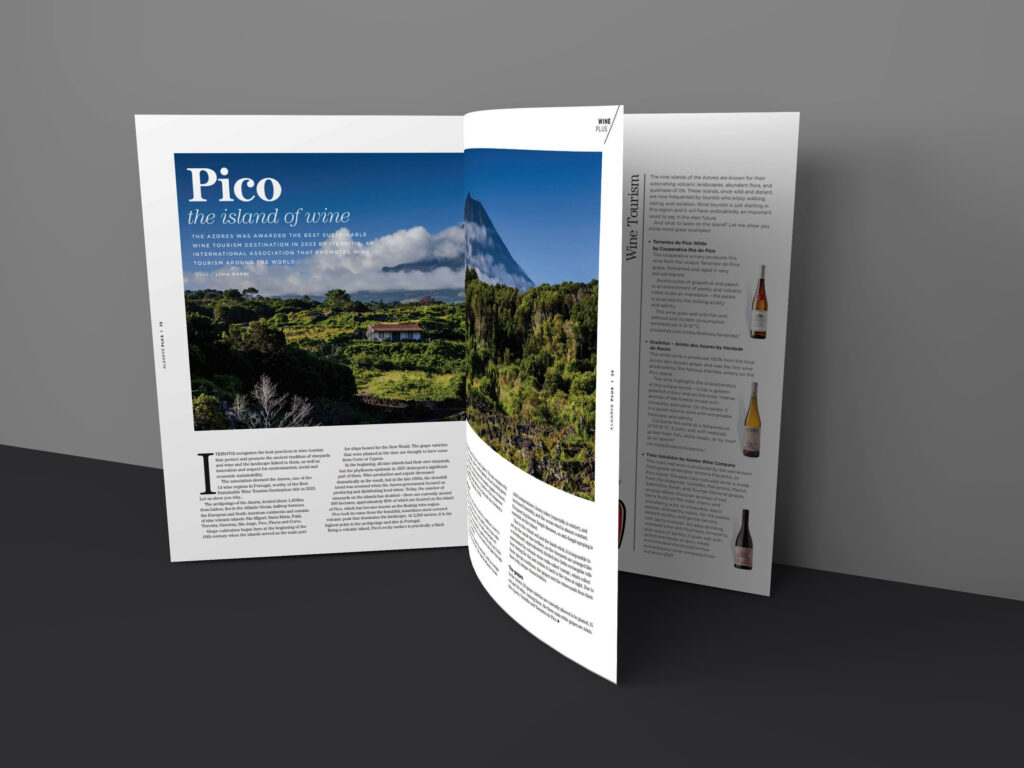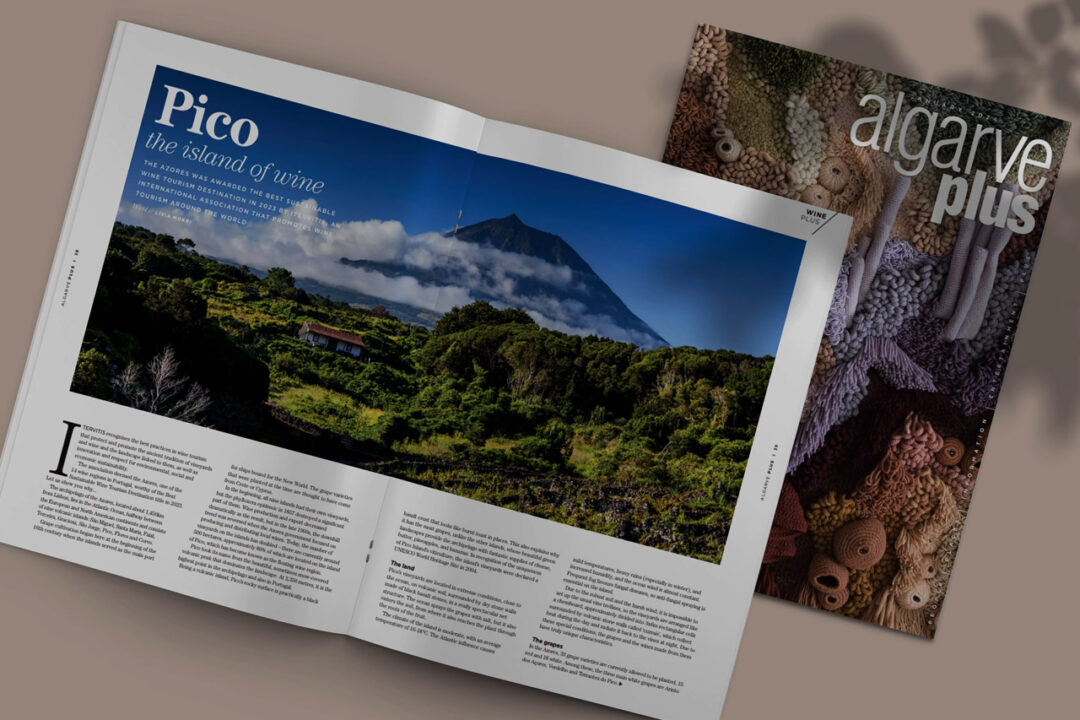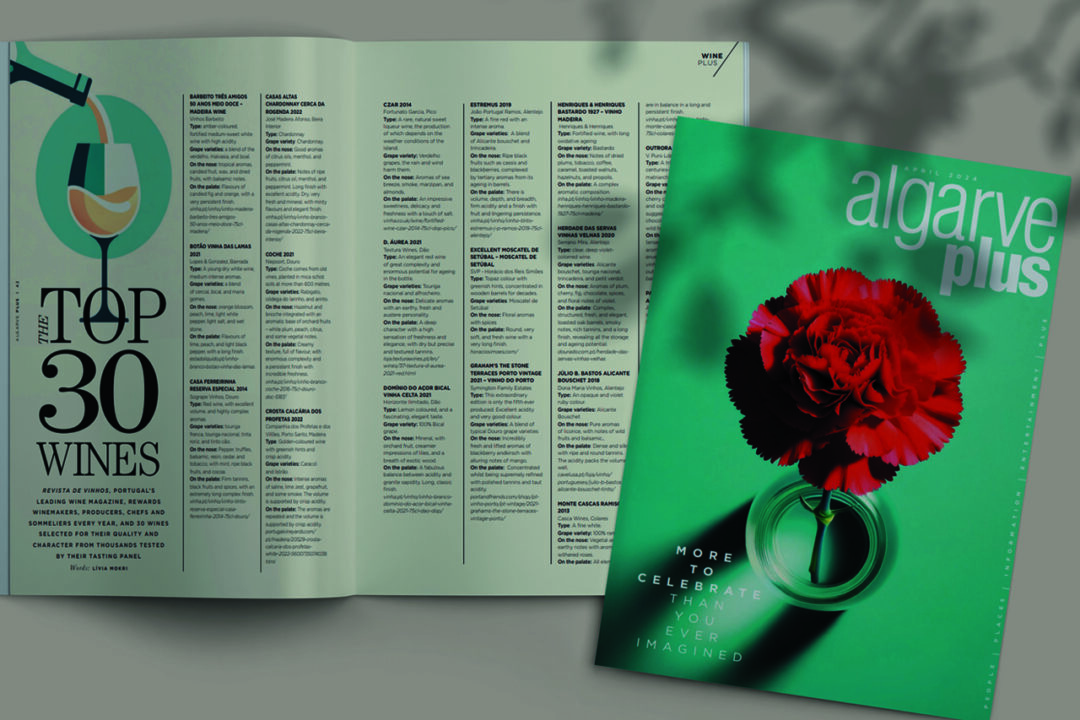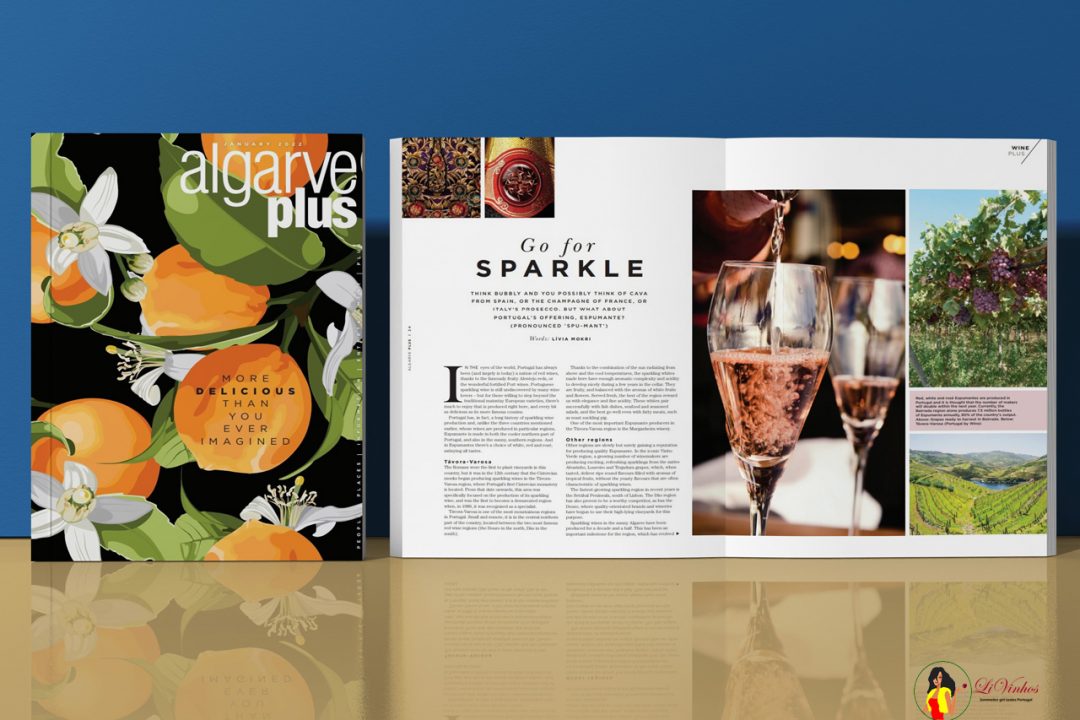PICO, THE ISLAND OF WINE –The Portuguese Azores archipelago was awarded the best sustainable wine tourism destination in 2023, by Itervitis, the international association that promotes wine tourism around the world.
The Portuguese Azores archipelago was awarded the best sustainable wine tourism destination in 2023, by Itervitis, the international association that promotes wine tourism around the world.
The distinction aims to reward the best practices in the area of wine tourism, that protect and promote the ancient tradition of vineyards and wine and the landscape linked to them, as well as innovation and respect for environmental, social, and economic sustainability.
So, let the new year be the time for our wine tour to explore the picturesque Azores as one of the 14 wine regions in Portugal.
I am happy to share that the January issue of the Algarve Plus Magazine has already been published with my new article about Pico, the island of wine in Portugal.
The magazine is readable online or downloaded for free here.
Or read here the whole article:
Pico, the island of wine
The archipelago of the Azores made up of nine islands, is located in the Atlantic Ocean, halfway between the European and North American continents.
Discovered the islands between the 14th and 15th centuries, grape cultivation began as early as the beginning of the 16th century when these islands served as the main port for ships bound for the New World. The grape varieties planted at that time are thought to come from Crete or Cyprus.
In the beginning, all nine islands had their own vineyards, but the phylloxera epidemic in 1857 destroyed a significant part of them, wine production and export decreased to a large extent, and the sale of Azorean wines became a real challenge. In the late 1900s, however, this trend changed dramatically. In line with European interests, the Azores government has made increased efforts to produce and distribute local wines, thanks to which the number of vineyards on the islands has doubled, so that there are currently around 500 hectares, approximately 80% of which are located on the island of Pico.
Thanks to the increased number of tourists coming to this beautiful location, the popularity of local wines has also increased, and Pico Island’s nickname was formed: the floating wine region.
Located about 1,450 km from Lisbon, the Portuguese archipelago consists of nine volcanic islands: São Miguel, Santa Maria, Faial, Terceira, Graciosa, São Jorge, Pico, Flores and Corvo.
Pico took its name from the beautiful, sometimes snow-covered volcanic peak that dominates the landscape. With its height of 2,350 meters, this peak is the highest point in the archipelago and also in Portugal.
Being a volcanic island, its rocky surface is practically a black basalt crust that looks like burnt toast in places. This also explains why Pico has the most grapes, unlike the other islands, whose beautiful green landscapes provide the archipelago with fantastic supplies of cheese, butter, pineapples, and bananas.
In recognition of the uniqueness of Pico Island’s viticulture, the island’s vineyards were declared a UNESCO World Heritage Site in 2004.
Terroir
Pico’s vineyards are located in extreme conditions, close to the ocean, on volcanic soil, surrounded by dry stone walls made of black basalt stones, in a really spectacular net structure. Due to the distance of about 50-300 meters, the ocean sprays the grapes with salt, but it also enters the soil, from where it also reaches the plant through the roots of the fruit.
The climate of the island is moderate, with an average temperature of 16-18 degrees, which is also strongly influenced by the proximity of the ocean. The Atlantic influence causes mild temperatures, heavy rains (especially in winter), and increased humidity, and the ocean wind is almost constant. Frequent fog favors fungal diseases, so anti-fungal spraying is essential on the island.
Due to the robust soil and the harsh wind, it is impossible to set up the usual vine trellises, so the vineyards are arranged, like a chessboard, approx. divided into 3×6 m rectangular cells, they are surrounded by volcanic stone walls called ‘currais’, which collect heat during the day and radiate it back to the vines at night. Thus, they have quite effective protection against bad weather. Due to these special conditions, the grapes and the wines made from them have truly unique characteristics.
In the Azores, 33 grape varieties are currently allowed to be planted, 15 red and 18 white. Among these, the 3 main white grapes are Arinto dos Açores, Verdelho and Terrantez do Pico.
The Azores became a demarcated wine region in 1994. The majority of Azorean wines are white, fresh and tart thanks to the humid, temperate climate, and are mainly made from the three indigenous grape varieties mentioned above, while the red wines are made from Merlot, Syrah, and other hybrid varieties.
Currently, the islands produce about one million liters of wine, most of which is sold locally, and only 10% are liqueur wines. The latter offers remarkable freshness and acidity. The most outstanding of them is the liqueur wine from Pico Island, which has been highly valued since the 18th century.
The Czar liqueur wine of Pico
The ‘Czar’ wine, produced in the Criação Velha area of the hundred-year-old vineyards of the volcanic Pico Island, is the only wine in the world that naturally reaches 20% alcohol level.
Liqueur wines have a long tradition on the island, and Tolstoy already referred to them in his work ‘War and Peace’. In 1820, more than 23,000 liters of late-harvest wine were sent from the island to St. Petersburg, to the tsar’s court.
Unfortunately, phylloxera essentially stopped the island’s wine production in 1850, leaving only the vineyards of Criação Velha intact. The father of the current winemaker, José Duarte Garcia, bought the estate in the 1960s, where he started making non-fortified liqueur wines. Originally he didn’t even bottle his drink, it was consumed with family and friends. But after Duarte learned that in 1917 a large quantity of late-harvest wine from Pico Island had been found in the cellars of Czar Miklós II, he decided to start bottling his wine under the Czar name, in order to boost the island’s wine production and reputation again. To this day, he uses his own hand-drawn logo and label on his bottles.
The first Czar wines were bottled in 1969 and sold the next year, which, in the first years was mainly consumed by locals and tourists. But from the beginning of the 2000s, the wine won medals one after another, both at local and international wine competitions.
This high-acid, low-sugar liqueur wine contains all three main Azores white grape varieties, usually harvested and pressed after September 15th, then naturally fermented before being placed in old French oak barrels. During fermentation, the wine reaches a minimum alcohol content of 18.5%.
Since the Czar wine – unlike Port wine – is never fortified with added alcohol, the resulting style is a product of the given vintage, so a different kind of wine is actually born every year.
The wine is aged for 8 years in barrels to make it richer in aroma and taste. The cellar is warm, the humidity is around 70%, so according to the winemaker’s estimate, each barrel loses approx. 70-80 liters due to evaporation.
The resulting drink has a deep amber color, aromas of nuts, caramel, malt, and tobacco, and flavors of raisins and apricots.
.
Wine Tourism
The nine islands of the Azores are known for their astonishing volcanic landscapes, abundant flora, and quietness of life. These islands, once wild and distant, are now frequented by tourists who enjoy walking, sailing, and isolation. Wine tourism is just starting in this region and it will have undoubtedly an important word to say in the near future.
And what to taste on the island? Let me show you some more great examples!
This white wine is produced 100% from the local Arinto dos Açores grape. And the first wine produced by this famous Alentejo winery on the Pico Island.
The wine highlights the characteristics of this unique terroir. It has a golden-greenish color. On the nose, intense aromas of sea breeze mixed with minerality and saline. On the palate, a good-volume wine with remarkable freshness and salinity.
Consume this wine at a temperature of 10-12 °C.
Pairing well with seafood, grilled fresh fish, white meats, or by itself as an aperitif.
This rustic red wine is produced by the well-known Portuguese winemaker, António Maçanita, on Pico Island.
The pale ruby-colored drink is made from the Aragonês, Castelão, Malvarisco, Merlot, Saborinho, Syrah, and Touriga Nacional grapes, among others.
Aromas of red berry fruits on the nose, cherry and strawberry, a bit of smokiness, black pepper, and earthy notes. On the palate, elegant acidity, and gentle tannins, with spicy nuances. An easy-drinking, unoaked wine with fruitiness, minerality, and notes of salinity.
Because of its saltiness, it goes well with grilled red meats or spicy meals.
This cooperative winery produces this wine from the unique Terrantez do Pico grape, fermented and aged in very old oak barrels.
Aroma notes of grapefruit and peach in an environment of earthy and volcanic notes. The palate is surprised by the striking acidity and salinity.
The best consumption temperature is 12-13 °C.
Goes well with fish and seafood.







No Comments Found